Infant Death
Medicolegal View
Definitions
- Infanticide: It means unlawful destruction of a newly born child and is regarded as murder in law.
- Feticide: It means killing of fetus prior to birth.
Causes
Infant death can occur due to either:
- Acts of commission
- Acts of omission
Acts of Commission These are willful acts done to cause the death of an infant. It includes:
- Suffocation
- Strangulation
- Drowning
- Head injury
- Fracture-dislocation of cervical spine
- Concealed puncture marks (pithing)
- Poisoning.
Acts of Omission Acts of omission refer to failure to take care of the child or being negligent towards the child during or after birth. It includes:
- Failure to provide assistance during labor.
- Failure to clear the air passage after birth.
- Failure to cut and ligate the umbilical cord.
- Failure to feed the child.
- Failure to protect the child from heat or cold.
Medicolegal Questions
The following questions are raised while doing an autopsy on an infant:
- Was the child stillborn or dead?
- Was the child born alive (i.e., live-born)?
- If born alive, how long did the infant live after birth?
- What was the cause of death?

How to Examine a Post-Mortem Newborn

Examination of a Newborn
We should examine the following:
- Weight and measurement
- External examination
- Examination of head and neck
- Vertebra and spinal cord
- Mouth and pharynx
- Thorax and abdomen
- Abdominal organs
- The skeleton
- The placenta
Weight and Measurement
- Size must be measured accurately and compared with known standards.
- Length:
- Crown-heel length by thread
- A graduated board

External Examination
- The external surface of the body is examined for evidence of maceration, cyanosis, petechial hemorrhages, injury, and skin lesions, and the orifices are examined for patency.
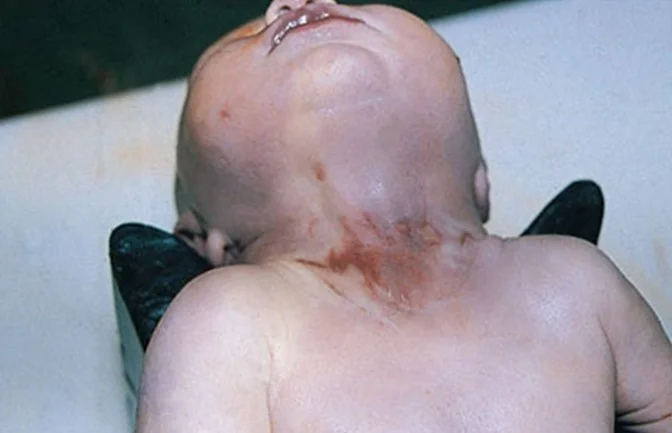
Examination of the Skeleton
- It’s better to have an X-ray photograph for each baby coming to necropsy.
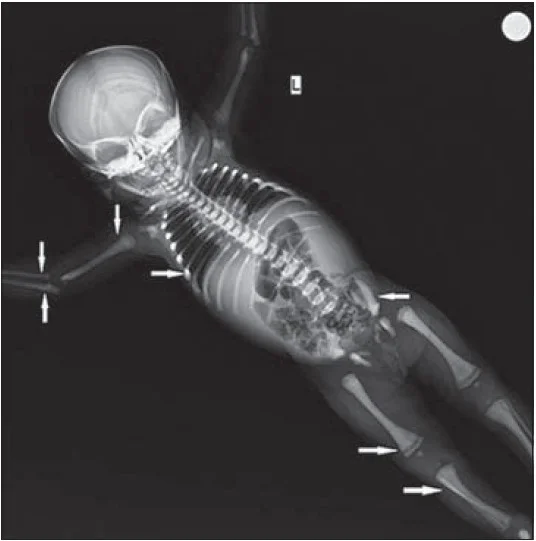

Still-Born (Still Birth) Child
Definition: The child which has issued forth from the mother after the 28th week of pregnancy and did not at any time, after being completely expelled, breathe, or show any other signs of life.
Thus, a still-born child is alive in the uterus up to the initiation of the birth process and died during the process (i.e., delivery) but did not show any sign of life after being completely born.
Dead-Born Child (Dead Birth)
- Definition: A dead-born child is one that had died in the uterus before the birth process begins and may show rigor mortis, maceration, or mummification at birth.
- Fetal death has been defined by the World Health Organization (WHO) as “death before complete expulsion or extraction from its mother of a product of conception, irrespective of the duration of pregnancy.”

Maceration
It is a process of aseptic autolysis occurring in a fetus that remains dead in the uterus surrounded by liquor amnii. Maceration in a fetus is a sign of death.
Mechanism: The cells of the fetus break down after death, and due to enzymatic action (autolysis), the body becomes soft and flaccid. Unlike putrefaction or decomposition, there is no bacterial action in maceration.
Duration required: If the fetus remains in the uterus after death, then the earliest sign of maceration is seen at about 6 to 12 hours in the form of areas of desquamation and appearance of brown-red discoloration of the umbilical cord stumpa.
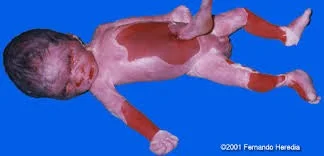
Features of Maceration
-
The macerated fetus is soft and flabby and flattens when kept on a table.
-
Emits a sweetish disagreeable smell.
-
The earliest sign of maceration is skin slippage (seen at 6-12 hours).
-
Skin is sodden and shows red or purple coloration with large blebs (or blisters) containing serous or sero-sanguineous fluid. The epidermis is easily peeled off, leaving moist, greasy areas underneath.
-
Abdomen is distended.
-
Joints become abnormally mobile or flexible with bones getting flexible and easily detached from the soft parts.
-
Skull bones show loss of alignment, and they override each other due to shrinkage of the brain after death, known as Spalding’s sign. The brain becomes pulpy and grayish-red in color.
-
Body cavities contain reddish serous fluid.
-
Internal organs become soft and edematous.
-
Umbilical cord is red, smooth, softened, and thickened.
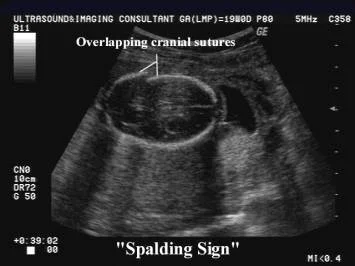
Mummification
It is the drying and shrinking of a fetus occurring in the uterus after death.
It results when liquor amnii is scanty and no air enters the uterus.
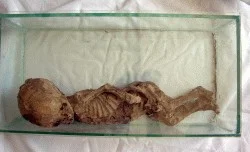
Putrefaction
If the membranes are ruptured early and air enters the uterus, then the dead fetus shows signs of putrefaction instead of maceration.

Live-Born Child (Live-Birth)
A child showing a sign of life, even when only part of the child is out of the mother, though the child has not breathed or been completely born, is considered a live-born child.
Causing the death of such a child is treated in the same manner as homicide.
Viability of Child
Viability means the ability of a fetus to lead a separate existence after birth by virtue of a certain degree of development. A child is viable after 210 days or 7 months or 30 weeks of intrauterine life.
Evidence of Live Birth (Signs of Live Birth)
Following are considered signs of live birth:
- Crying of the baby
- Movement of the body or hand or foot
- Muscle twitching or twitching of the eyelid.
Additional ConditionsZ
- Vagitus uterinus: Crying of a child even when it is in the uterus.
- Vagitus vaginalis: Crying of a child even when it is in the vagina.
Thus, it may possible that child may didn’t show any sign when it comes out although cry of child is heard by people. So crying of child is not conclusive proof of live birth**.**
External and Internal Autopsy Findings in Live Birth
External Changes
-
- Changes in the chest
-
- Changes in the skin
-
- Changes in the umbilicus
Internal Changes
-
- Changes in the lung
-
- Position of the diaphragm
-
- Changes in the heart and circulation
-
- Changes in the gastrointestinal tract
-
- Changes in the middle ear
-
- Changes in the kidneys
-
- Changes in the blood
Changes in Umbilicus and Umbilical CordZ
| Features | Time |
|---|---|
| Shrinkage of lumen of blood vessels | Just born |
| Cut margin of cord dries up with blood clot | 2 hours |
| Contraction of umbilical arteries | 10 hours |
| Drying of cord | 24 hours (1 day) |
| Inflammatory line (red ring) at the base of the umbilical cord stump | 48 hours (2 days) |
| Shriveled and mummified cord | 2-3 days |
| Obliteration in umbilical vein | 4-5 days |
| Cord shriveled, dry, and falls off | 5-6 days |
| Complete healing of umbilicus | 7-10 days - in some ethnicities 20 days |
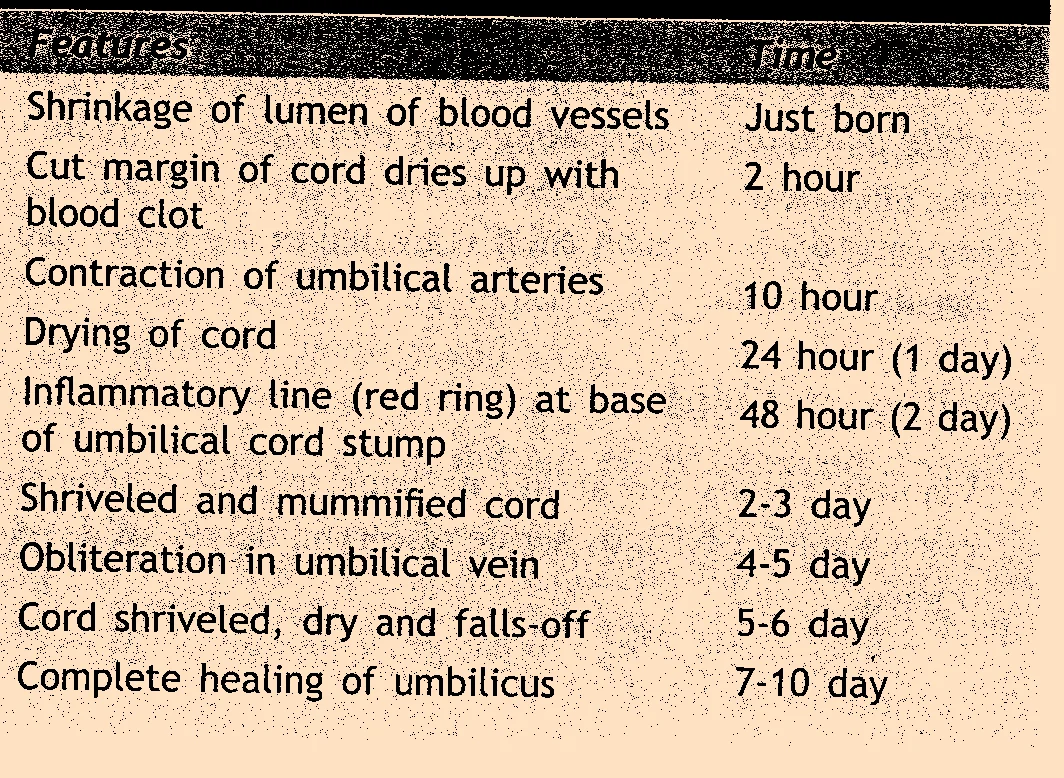

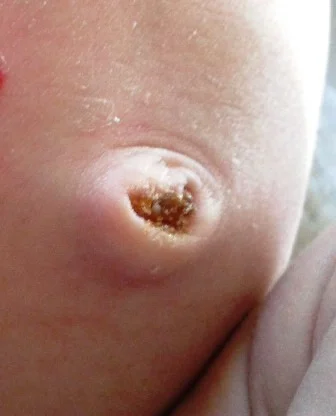
Gross and Microscopic Examination of the Lungs
Here’s the converted table based on the provided image:
| Attribute | Non-Respired Lungs Appear | Respired Lung |
|---|---|---|
| Volume | Small, collapsed, lie in the back part of chest on side of vertebral column. | Filling the whole pleural cavities and medial margin overlaps the mediastinum and pericardium. |
| Color | Reddish-brown and hard in consistency like a liver, non crepitant. | Bright red or pinkish with mottled appearance, spongy, elastic and crepitant. |
| Cut Section | Uniform, hard and exude little froth-less fluid. | Spongy and exude frothy blood. |
| Margins | Sharp | Rounded |
| Microscopy | Alveolar lining epithelium is cuboidal to columnar with less vascularization. | Alveoli appear expanded with flattening of epithelium and increased vascularization |
| Static Test / Fodere’s Test (Weight) | Weight of lungs (both) varies from 30 to 40 gm. | From 60 to 70 gm. |
| Ploucquet’s Test (Weight Ratio) | Weight of both lungs is about 1/70th of the weight of whole fetus. | About 1/35th of the weight of whole fetus. |
| Specific Gravity | 1040 to 1050 | 940 to 950 |
| Hydrostatic Tests | Lung pieces sink | Lung pieces float |
| Fallacies of Hydrostatic Test | Putrefaction - presence of gases of decomposition; Artificial respiration | Pulmonary edema; Pneumonia; Atelectasis - non-expansion of lung |
 | ||
 |
Sudden Infant Death Syndrome (SIDS)
Sudden Infant Death Syndrome (crib death) is the sudden death of an infant, usually under 1 year of age, which remains unexplained after a complete post-mortem investigation, including an autopsy, examination of the death scene, and review of the case history.
3,000 SIDS deaths per year in the U.S.
- Major cause of death in infants after the 1st month of life.
- Sudden & silent in an apparently healthy infant.
- Unpredictable & unpreventable.
- Quick death with no signs of suffering - usually during sleep.
SIDS - What It Is Not
- Caused by vomiting or choking.
- Caused by external suffocation or overlaying.
- Contagious or Hereditary.
- Child abuse.
- Caused by a lack of love.
- Caused by immunizations.
- Caused by an allergy to cow’s milk.
Typical SIDS Infant Scenario
- Almost always occurs during sleep or the appearance of sleep.
- Usually healthy prior to death.
- May have had a cold or recent physical stress.
- May have been placed down for a nap, found not breathing or appearing dead.
- Parents not hearing signs of struggle.